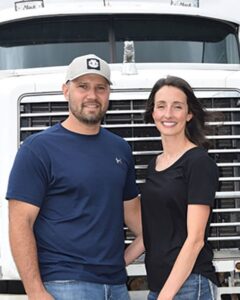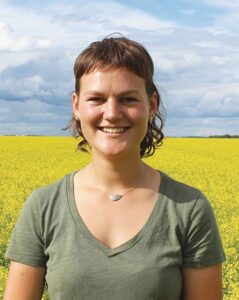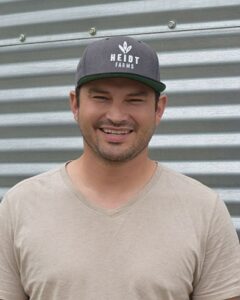How Do You Choose Your Canola Hybrids?
Canola Digest farmer panelists describe what cultivars they grew in 2022 and how they make their canola seed decisions.
 Breann and
Breann and
Bryce Moore
LeRoy, Saskatchewan
Breann and Bryce Moore operate Green Ash Acres and work off-farm jobs. Breann is a retail agronomist at Midway Co-op in LeRoy and Bryce is a professional agronomy consultant with Western Ag.
Canola represents about 40 per cent of the acres on their farm. Wheat, barley and oats account for most of the rest, with some acres dedicated to peas, fababeans, canaryseed or flax.
“I would like the blackleg resistance group marked on seed bags a little more clearly. We’re getting better as an industry, but there is still more work to do on rotating blackleg genes.”
—Bryce Moore
Their canola cultivars for 2022 are InVigor L340PC, InVigor L233P, P505MSL and P508MCL.
P508MCL from Pioneer Hi-Bred is a Clearfield cultivar they’ll sell into Bunge’s non-GMO program. “We like to have a little specialty canola on the farm,” Bryce says. The Clearfield cultivar, sprayed with Group-2 Ares, also gives them a different mode of action for fields that have Group-1 resistant wild oats. Group-1 clethodim, tank mixed with Liberty to enhance grassy weed, won’t work on the resistant wild oats.
The Moores normally like to rotate between canola systems, but couldn’t get the Roundup Ready hybrid they wanted from their Pioneer Hi-Bred seed retailer this year, so they opted for P505MSL, another Liberty Link.
They choose hybrids with pod-shatter tolerance and blackleg resistance. “I would like the blackleg resistance group marked on seed bags a little more clearly,” Bryce says. “We’re getting better as an industry, but there is still more work to do on rotating blackleg genes.”
The Moores use Canola Performance Trial results (canolaperformancetrials.ca) to help with seed decisions.
Breann, through her retail experience, also gathers information on hybrid performance from the seed companies and from other farmers she talks to.
Why do they grow four cultivars? They do their homework on cultivar selection because “we don’t want to put in a dud,” Bryce says. And they want to keep trying what’s new. L233P, an earlier-maturity cultivar, is their go-to, he says, but they choose a couple of others each year to gain “real on-farm experience.”
While the Moores don’t have clubroot confirmed on the farm, they will choose new cultivars with clubroot resistance because they are also high performers. P505MSL, for example, has clubroot, blackleg and sclerotinia resistance.
“At the end of the day, yield is the main driver,” Bryce says.
 Melissa Damiani
Melissa Damiani
Bluffton, Alberta
Melissa Damiani farms in a short-season area within sight of the Rocky Mountains in central Alberta. “Maturity is one of the most important things on my list. You can have the best yielding variety out there, but if it doesn’t mature in time, what good is that?” Damiani says, adding, “It is hard to find maturity that is short enough.” She says she mentions this fact to seed company representatives at every field day she attends.
Their canola seed decisions usually start with herbicide tolerance. “We like to switch between Roundup and Liberty traits to help control volunteers and switch up genetics,” she says. She particularly likes the Roundup Ready TruFlex system because the higher allowed glyphosate rates take care of problem perennials like quackgrass and thistles. They grew DKTF98CR this year.
She says clubroot resistance is a must. “We are lucky we haven’t seen clubroot in our fields, and I would like to keep it that way,” she says. “I know it’s around.”
“Maturity is one
of the most important things on my list. You can have the best yielding variety out there, but if it doesn’t mature in time, what good is that?”
—Melissa Damiani
They also look for cultivars with good standability and harvestability, as well as pod integrity. “Anything to make things go quicker and smoother during that busy time of year is worth a lot,” Damiani says. Although they swath canola, pod integrity is still valuable because they can “feel better about pushing that swath date back a bit to capture that extra yield or if the weather isn’t cooperating.”
In addition to farming and parenting, Damiani is the branch manager for Nutrien in nearby Rimbey. “The job gives me a huge network, including agronomists, growers and seed reps, who I can talk to about what they liked and didn’t like about a variety. I also get to look at lot of different fields, and get a first look at a lot of stuff,” she says. “I take it all in. I love it.”
Growers can learn a lot about cultivar performance at the local level by building relationships with retails, grain buyers and agronomists, she says.
“I believe it’s important to switch up our genetics to prevent resistance issues and keep things working and improving,” Damiani says. “It can feel stressful trying new varieties, especially when you find something you currently like, but if you do the research and see how they have performed in fields or areas similar to yours, you can feel pretty good about taking the leap and trying something new.”
 Fiona Jochum
Fiona Jochum
St. François Xavier, Manitoba
Fiona Jochum says harvestability is the most important trait for their canola seed. “We straight cut all of our canola, so it is paramount that a hybrid have good pod shatter tolerance, and stand up as well,” Jochum says. “That makes harvest go so much smoother.”
This could be particularly important for 2022 after excess moisture delayed the season. “Seeding was so rushed,” she says. Crops were seeded within a narrow window, which means they could all be ready to harvest around the same time. “The pod shatter trait will protect those crops that have to stand and wait.”
“It’s good to always try something new, otherwise you don’t know what you might be missing.”
—Fiona Jochum
For 2022, the Jochums grew InVigor L233P, InVigor L340PC, InVigor L356PC and DKLL83SC. All are Liberty Link.
“Herbicide system is the next most important trait after harvestability,” Jochum says. They grow Roundup Ready soybeans, so with Liberty Link canola they can rotate with different herbicide groups.
L233P has “always been a performer,” Jochum says. “We’ll keep growing it until something else can knock it out of the park or until the seed company stops selling it.”
L340PC, which is comparable to L233P, she says, gets a lot of acres “because we don’t want to put the whole farm to one variety.” It also has clubroot resistance, which isn’t a “make or break” selling feature for them at this time. “Although it’s coming for all of us,” she adds.
The farm put a few acres into L356PC and DKLL83SC. “It’s good to always try something new, otherwise you don’t know what you might be missing,” Jochum says. The InVigor retailer encouraged them to try a few acres of L356PC, and a local Bayer rep promoted DKL83SC as a high yielder with improved pod shatter tolerance. So they tried a couple of bags, putting it up against L340PC.
 Josh Heidt
Josh Heidt
Kerrobert,
Saskatchewan
The Heidt farm grew four canola cultivars in 2022 – InVigor L356PC, InVigor L345PC, PV581GC and PV781TCM. “We decide what cultivar goes on what field based on the history of weed pressure,” says Josh Heidt. For example, the glyphosate-resistant cultivars will go on field with Group-1 resistant wild oats.
“We don’t have any confirmed cases of clubroot, but we don’t have to go far up the road to find it. We want to stay ahead of the game on that because it’s important that we protect canola. I’m happy to sacrifice a bushel or two of yield if it means we protect the farm from clubroot.”
—Josh Heidt
In general, about a quarter of their canola acres will get a glyphosate-resistant cultivar and the other three quarters are glufosinate-resistant cultivars. All will have clubroot resistance.
“We don’t have any confirmed cases of clubroot, but we don’t have to go far up the road to find it,” Heidt says. “We want to stay ahead of the game on that because it’s important that we protect canola. I’m happy to sacrifice a bushel or two of yield if it means we protect the farm from clubroot.”
The Heidts use the grower-funded independent Canola Performance Trials when making seed decisions. “I’m always looking at how an individual variety will work on our farm,” he says. Each year, they’ll grow one or two they like and add one or two new ones.
PV581GC is an older cultivar from Nutrien, which is the main retailer in Kerrobert. “It’s a swathed variety that grows tall, so it has the stubble to hold on to the swaths,” he says. They usually swath their glyphosate-resistant cultivars and straight cut their InVigors, spraying them with a combination of glyphosate and Heat for uniform dry down.
 Murray Lewis
Murray Lewis
Cleardale, Alberta
Murray Lewis planned to seed four canola cultivars in 2022 – DKTFLL 21 SC from Dekalb, 44H44 from Pioneer Hi-Bred, InVigor L345PC from BASF, and InVigor L233P from BASF.
“But there can be a difference between what you plan to seed and what you actually get seeded,” Lewis says. With excess spring rainfall, he only seeded about two thirds of his acres. He didn’t get his Dekalb and Pioneer Hi-Bred canola cultivars in the ground.
Lewis usually has a three-year break between canola crops, using a rotation of canola-cereals-peas-cereals. Cereals are mostly wheat, but sometimes malt barley or oats. He will often alternate between canola herbicide systems. “If a field gets Roundup Ready canola the first time, then it gets Liberty Link the next time,” he says.
“If a field gets Roundup Ready canola the first time, then it gets Liberty Link the next time.”
—Murray Lewis
InVigor L233P has been a good cultivar for the farm, Lewis says. “L345PC is newer, carrying off of L233P, which I really like, so I tried a couple of bags last year,” he says. This year one third of his InVigor acres were L345PC. The newer cultivar also has clubroot resistance, though that is “not a big deal yet” on his farm, he says.
Lewis straight combines all canola, so pod shatter tolerance is a trait he looks for.
Maturity factors somewhat into the canola seed decision. “I wouldn’t try anything long season,” Lewis says. He has “run out of season” on some cultivars, but rather than select the earliest cultivars, Lewis tries to choose ones that are less likely to regrow if they get a shot of moisture late in the season. Regrowth ratings are not available, so Lewis relies on farmer experience – which is why he likes to stick with cultivars that work well for him. “With L233P, when it’s done, it’s done,” he says.





